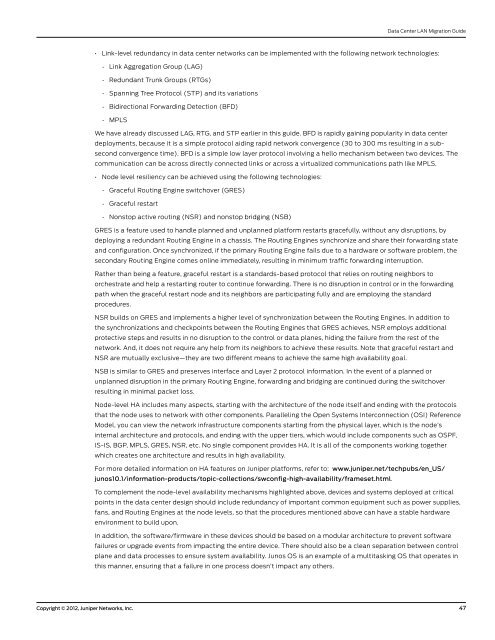Data Center LAN Migration Guide - Juniper Networks
Data Center LAN Migration Guide - Juniper Networks
Data Center LAN Migration Guide - Juniper Networks
You also want an ePaper? Increase the reach of your titles
YUMPU automatically turns print PDFs into web optimized ePapers that Google loves.
<strong>Data</strong> <strong>Center</strong> <strong>LAN</strong> <strong>Migration</strong> <strong>Guide</strong><br />
• Link-level redundancy in data center networks can be implemented with the following network technologies:<br />
- Link Aggregation Group (LAG)<br />
- Redundant Trunk Groups (RTGs)<br />
- Spanning Tree Protocol (STP) and its variations<br />
- Bidirectional Forwarding Detection (BFD)<br />
- MPLS<br />
We have already discussed LAG, RTG, and STP earlier in this guide. BFD is rapidly gaining popularity in data center<br />
deployments, because it is a simple protocol aiding rapid network convergence (30 to 300 ms resulting in a subsecond<br />
convergence time). BFD is a simple low layer protocol involving a hello mechanism between two devices. The<br />
communication can be across directly connected links or across a virtualized communications path like MPLS.<br />
• Node level resiliency can be achieved using the following technologies:<br />
- Graceful Routing Engine switchover (GRES)<br />
- Graceful restart<br />
- Nonstop active routing (NSR) and nonstop bridging (NSB)<br />
GRES is a feature used to handle planned and unplanned platform restarts gracefully, without any disruptions, by<br />
deploying a redundant Routing Engine in a chassis. The Routing Engines synchronize and share their forwarding state<br />
and configuration. Once synchronized, if the primary Routing Engine fails due to a hardware or software problem, the<br />
secondary Routing Engine comes online immediately, resulting in minimum traffic forwarding interruption.<br />
Rather than being a feature, graceful restart is a standards-based protocol that relies on routing neighbors to<br />
orchestrate and help a restarting router to continue forwarding. There is no disruption in control or in the forwarding<br />
path when the graceful restart node and its neighbors are participating fully and are employing the standard<br />
procedures.<br />
NSR builds on GRES and implements a higher level of synchronization between the Routing Engines. In addition to<br />
the synchronizations and checkpoints between the Routing Engines that GRES achieves, NSR employs additional<br />
protective steps and results in no disruption to the control or data planes, hiding the failure from the rest of the<br />
network. And, it does not require any help from its neighbors to achieve these results. Note that graceful restart and<br />
NSR are mutually exclusive—they are two different means to achieve the same high availability goal.<br />
NSB is similar to GRES and preserves interface and Layer 2 protocol information. In the event of a planned or<br />
unplanned disruption in the primary Routing Engine, forwarding and bridging are continued during the switchover<br />
resulting in minimal packet loss.<br />
Node-level HA includes many aspects, starting with the architecture of the node itself and ending with the protocols<br />
that the node uses to network with other components. Paralleling the Open Systems Interconnection (OSI) Reference<br />
Model, you can view the network infrastructure components starting from the physical layer, which is the node’s<br />
internal architecture and protocols, and ending with the upper tiers, which would include components such as OSPF,<br />
IS-IS, BGP, MPLS, GRES, NSR, etc. No single component provides HA. It is all of the components working together<br />
which creates one architecture and results in high availability.<br />
For more detailed information on HA features on <strong>Juniper</strong> platforms, refer to: www.juniper.net/techpubs/en_US/<br />
junos10.1/information-products/topic-collections/swconfig-high-availability/frameset.html.<br />
To complement the node-level availability mechanisms highlighted above, devices and systems deployed at critical<br />
points in the data center design should include redundancy of important common equipment such as power supplies,<br />
fans, and Routing Engines at the node levels, so that the procedures mentioned above can have a stable hardware<br />
environment to build upon.<br />
In addition, the software/firmware in these devices should be based on a modular architecture to prevent software<br />
failures or upgrade events from impacting the entire device. There should also be a clean separation between control<br />
plane and data processes to ensure system availability. Junos OS is an example of a multitasking OS that operates in<br />
this manner, ensuring that a failure in one process doesn’t impact any others.<br />
Copyright © 2012, <strong>Juniper</strong> <strong>Networks</strong>, Inc. 47

















